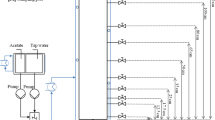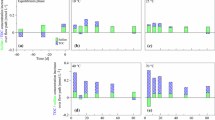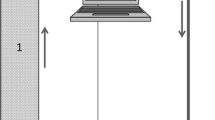Abstract
Aquifer thermal energy storage in urban and industrial areas can lead to an increase in subsurface temperature to 70 °C and more. Besides its impacts on mineral and sorption equilibria and chemical reaction kinetics in an aquifer, temperature sensitively influences microbial activity and thus redox processes, such as sulphate reduction. Microorganism species can only operate within limited temperature ranges and their adaptability to temperature is a crucial point for the assessment of the environmental consequences of subsurface heat storage. Column experiments with aquifer sediment and tap water at 10, 25, 40, and 70 °C showed that under the constant addition of acetate sulphate reduction could be initiated after 26–63 pore volumes exchanged at all temperatures. Fastest initiation of sulphate reduction with the highest reduction rates was found at 40 °C. Maximum rate constants during experimental run-time were 0.56 h−1 at 40 °C and 0.33, 0.36, and 0.25 h−1 at 10 and, 25, and 70 °C, respectively. Hence, microbial activity was enhanced by a temperature increase to 40 °C but was significantly lowered at 70 °C. At 25 °C methane was found in solution, indicating the presence of fermenting organisms; at 10, 40, and 70 °C no methane production was observed. It could be shown that redox processes in an aquifer generally can adapt to temperatures significantly higher than in situ temperature and that the efficiency of the reduction process can be enhanced by temperature increase to a certain limit. Enhancement of sulphate reduction in an aquifer due to temperature increase could also allow enhanced degradation of organic ground water contaminants such as BTEX, where sulphate is an important electron acceptor.






Similar content being viewed by others
References
Arning E, Kölling M, Panteleit B, Reichling J, Schulz HD (2006) Einfluss oberflächennaher Wärmegewinnung auf gechemische Prozesse im Grundwasserleiter. Grundwasser 1:27–39
Atlas RM, Bartha R (1998) Microbial ecology—fundamentals and applications, 4th edn. Benjamin/Cummings Science Publishing, California
Bethke CM, Sanford RA, Kirk MF, Jin Q, Flynn TM (2011) The thermodynamic ladder in geomicrobiology. Am J Sci 311:183–210
Bremner JM, Shaw K (1958) Denitrification in soil. II. Factors affecting denitrification. J Agric Sci 51:40–52
Brielmann H, Lueders T, Schreglmann K, Ferraro F, Avramov M, Hammerl V, Blum P, Bayer P, Griebler C (2011) Oberflächennahe Geothermie und ihre potenziellen Auswirkungen auf Grundwasserökosysteme. Grundwasser 16:77–91
Brons HJ, Griffioen J, Appelo CAJ, Zehnder AJB (1991) (Bio)Geochemical reactions in aquifer material from a thermal energy storage site. Water Resour Res 25(6):729–736
Canfield DE, Rauiswell R, Bottrell S (1992) The reactivity of sedimentary iron minerals toward sulfide. Am J Sci 292:659–683
Dettmer K (2002) A discussion of the effects of thermal remediation treatments on microbial degradation processes. National Network of Environmental Management Studies Fellow for US EPA
Dou J, Liu X, Hu Z, Deng D (2008) Anareobic BTEX biodegradation linked to nitrate and sulfate reduction. J Hazard M 151:720–729
Ebert M (1997) Der Einfluss des Redoxmilieus auf die Mobilität von Chrom im durchströmten Aquifer. Dissertation, Universität Bremen
Elsgaard L, Isaksen MF, Jorgensen BB, Alayse A-M, Jannasch HW (1994) Microbial sulafte reduction in deep-sea sediments at the Guaymas Basin hydrothermal vent are: influence of temperature and substrates. Geochim Cosmochim Acta 58(16):3335–3343
Griffioen J, Appelo CAJ (1993) Nature and extent of carbonate precipitation during aquifer thermal energy storage. Appl Geochem 8:161–176
Harada H, Uemura S, Momonoi K (1994) Interaction between sulfate-reducing bacteria and methane-producing bacteria in UASB reactors fed with low strength wastes containing different levels of sulfate. Water Res 28(2):355–367
Hölting B (1996) Hydrogeologie. Einführung in die Allgemeine und Angewandte Hydrogeologie, vol 5. Enke
Li X, Chen Z, Zhao J (2006) Simulation and experiment on the thermal performance of U-vertical ground coupled heat exchangers. Appl Therm Eng 26:1564–1571
Liamleam W, Annachhatre AP (2007) Electron donors for biological sulfate reduction. Biotechnol Adv 25:452–463
Lovley DR, Klug MJ (1983) Sulfate reducers can outcompete methanogens at freshwater sulfate concentrations. App Environ Microbiol 45(1):187–192
Lovley DR, Phillips EJP (1988) Manganese inhibition of microbial iron reduction in anaerobic sediments. Geomicrobiol J 6:145–155
Maree JP, Strydom WF (1987) Biological sulphate removal from industrial effluent in an upflow packed bed reactor. Water Res 21(2):141–146
Meier J, Costa R, Smalla K, Boehrer B, Wendt-Potthoff K (2005) Temperature dependence of Fe(III) and sulfate reduction rates and its effect on growth and composition of bacterial enrichments from an acidic pit lake neutralization experiment. Geobiology 3:261–274
Mohn WW, Tiedje JM (1992) Microbial reductive dehalogenation. Microbiol Rev 56(3):482–507
Okabe S, Characklis WG (1992) Effects of temperature and phosphorous concentration in microbial sulfate reduction by Desulfovibrio desulfuricans. Biotechnol Bioeng 39:1031–1042
Pallud C, Van Cappellen P (2006) Kinetics of microbial sulfate reduction in estuarine sediments. Geochim Cosmochim Acta 70:1148–1162
Rabus R, Brüchert V, Amann J, Könneke M (2002) Physiological response to temperature changes of the marine, sulfate-reducing bacterium Desulfobacterium autotrophicum. FEMS Microbiol Ecol 42:409–417
Rintala J, Lettinga G (1992) Effects of temperature elevation from 37 to 55 °C on anaerobic treatment of sulphate rich acidified wastewaters. Environ Technol 13:801–812
Roychoudhury AN, Merrett GL (2006) Redox Pathways in a petroleum contaminated shallow sandy aquifer: iron and sulfate reductions. Sci Total Environ 366:262–274
Schmidt T (2005) Müller-Steinhagen H Erdsonden- und Aquifer-Wärmespeicher in Deutschland. In: OTTI Profiforum Oberflächennahe Geothermie, Regenstauf
Thauer RK, Möller-Zinkham D, Spormann AM (1989) Biochemistry of acetate catabolism in anaerobic chemotrophic bacteria. Annu Rev Microbiol 43:43–67
Westrich JT, Berner RA (1988) The Effect of Temperature on Rates of Sulfate Reduction in Marine Sediments. Geomicrobiol J 6:99–117
Yoda M, Kitagawa M, Miyaji Y (1987) Long term competition between sulfate-reducing and methane-producing bacteria for acetate in anaerobic biofilm. Water Res 21(12):1547–1556
Acknowledgments
This study was funded by the German Ministry of Science, Economic Affairs and Transport and the University of Kiel and was part of the “GeoCITTI” research project.
Author information
Authors and Affiliations
Corresponding author
Rights and permissions
About this article
Cite this article
Jesußek, A., Köber, R., Grandel, S. et al. Aquifer heat storage: sulphate reduction with acetate at increased temperatures. Environ Earth Sci 69, 1763–1771 (2013). https://doi.org/10.1007/s12665-012-2009-0
Received:
Accepted:
Published:
Issue Date:
DOI: https://doi.org/10.1007/s12665-012-2009-0




